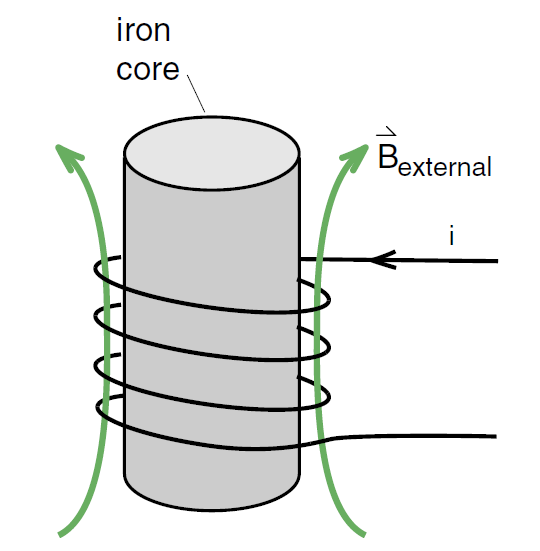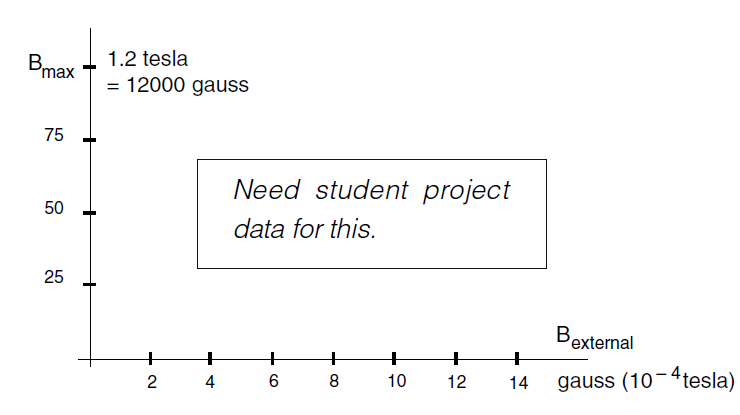


 الفيزياء الكلاسيكية
الفيزياء الكلاسيكية
 الكهربائية والمغناطيسية
الكهربائية والمغناطيسية
 علم البصريات
علم البصريات
 الفيزياء الحديثة
الفيزياء الحديثة
 النظرية النسبية
النظرية النسبية
 الفيزياء النووية
الفيزياء النووية
 فيزياء الحالة الصلبة
فيزياء الحالة الصلبة
 الليزر
الليزر
 علم الفلك
علم الفلك
 المجموعة الشمسية
المجموعة الشمسية
 الطاقة البديلة
الطاقة البديلة
 الفيزياء والعلوم الأخرى
الفيزياء والعلوم الأخرى
 مواضيع عامة في الفيزياء
مواضيع عامة في الفيزياء|
Read More
Date: 24-10-2020
Date: 3-1-2017
Date: 1-11-2020
|
The Electromagnet
If we insert a magnetically soft iron rod into the core of a solenoid as shown in Figure (1), we have an electromagnet. It only takes a small external field to align a majority of the magnetic moments in magnetically soft iron. And when the moments are aligned, we an get fields approaching one tesla, 104 gauss, as a result. This is the principle of an electromagnet where a weak field produced by a small current in the windings produces a strong field in the iron.

Figure 1: In an electromagnet, some turns of wire are wrapped around an iron bar. When a current i is turned on, the magnetic field of the turns of wire provide the external field to align the iron atoms. When the current i is shut off, and the external field disappears, the iron atoms return to a random alignment and the electromagnet shuts off. Whether the iron atoms remain aligned or not, whether we have a permanent magnet or not, depends upon the alloys (impurities) in the iron and the way the iron was cooled after casting.
Figure (2) is a graph showing the strength of the magnetic field inside the iron core of an electromagnet as a function of the strength of the external magnetic field produced by the windings of the solenoid. In this case a toroidal solenoid was used, the iron core is an iron ring inside the toroid, and the results in Figure (2) are for one particular sample of iron. We can get different results for different samples of iron prepared in different ways.
The vertical axis in Figure (2) shows the percentage of the maximum field Bmax we can get in the iron. Bmax is the “saturated” field we get when all the iron atoms magnetic moments are aligned and has a typical value of about 1 tesla. We see that a very small external field of 2 gauss brings the magnetic field up to 50% of its saturated value. Getting the other 50% is much harder. We can more or less turn on the electromagnet using a 2 gauss external field, and that not much is to be gained by using a stronger external field.

Figure 2: Example of a magnetization curve for magnetically soft iron. The impressive feature is that an external field of only a few gauss can produce fields in excess of xxxxx gauss inside the iron.



|
|
|
|
دراسة: إجراء واحد لتقليل المخاطر الجينية للوفاة المبكرة
|
|
|
|
|
|
|
"الملح والماء" يمهدان الطريق لأجهزة كمبيوتر تحاكي الدماغ البشري
|
|
|
|
|
|
بالصور: عند زيارته لمعهد نور الإمام الحسين (عليه السلام) للمكفوفين وضعاف البصر في كربلاء.. ممثل المرجعية العليا يقف على الخدمات المقدمة للطلبة والطالبات
|
|
|
|
ممثل المرجعية العليا يؤكد استعداد العتبة الحسينية لتبني إكمال الدراسة الجامعية لشريحة المكفوفين في العراق
|
|
|
|
ممثل المرجعية العليا يؤكد على ضرورة مواكبة التطورات العالمية واستقطاب الكفاءات العراقية لتقديم أفضل الخدمات للمواطنين
|
|
|
|
العتبة الحسينية تستملك قطعة أرض في العاصمة بغداد لإنشاء مستشفى لعلاج الأورام السرطانية ومركز تخصصي للتوحد
|